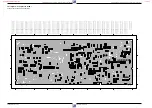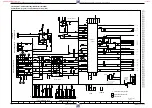
2 - 8
GRUNDIG Service-Technik
Beschreibungen / Descriptions
2.4.2 Löschoszillator
Der selbstschwingende Oszillator für den Haupt- und Tonlöschkopf
besteht aus dem Transistor T7603 und dem Resonanzkreis F5603 /
C2622. Von diesem wird auch die Vormagnetisierungsspannung
(BIAS) abgeleitet. Die Ansteuerung des Oszillators erfolgt über den
Aufnahme-Schaltpegel "IREC" (aktiv bei LOW) vom Ablaufrechner
IC7410-(3) und die folgenden Transistoren T7606 / T7605 / 7604.
2.4.3 Wiedergabe
Bei Wiedergabe erhält der AW-Kopf über IC7601-(1) und Steckerkon-
takt F8-7 Massepotential. Das vom AW-Kopf abgetastete NF-Signal
gelangt über F8-5 an IC7601-(6), -(2). Es durchläuft im IC7601 den
integrierten Wiedergabeentzerrer (EQ), wird über IC7601-(8) und den
Pegeleinsteller für Wiedergabe R3606 (PB-LEVEL) dem IC7601-(9)
zugeführt. Anschließend wird es in einem linearen Verstärker (AMP)
verstärkt. An Pin 13 verläßt das NF-Signal den IC7601. Nach dem
Kondensator C2611 wird es (AMLP) im "Video/Chroma, "IN/OUT"-
Schaltungsteil dem Modulator bzw. der EURO-AV-Buchse zugeführt.
Bei "LP"-Wiedergabe bewirken die Schalter EP CTL und LP CTL die
Entzerrungs-Umschaltung.
2.4.4 Stummschaltung
Der Mute-Befehl (MTA) vom Ablaufrechner IC7410-(2) dient dazu, die
Tonausgänge des IC7601 bei allen Funktionen, außer Wiedergabe
und Aufnahme, sowie bei Servofehlern stummzuschalten. Dazu erhält
der IC7601 über Pin 22 den Mute-Befehl "MTA" (aktiv bei HIGH).
2.4.2 Erase Oscillator
The free running oscillator for the full-track and sound erase heads
consists of the transistor T7603 and the resonant circuit F5603 /
C2622. From this oscillator also the bias voltage (BIAS) is derived. The
oscillator is operated from the record switching voltage "IREC" (active
at LOW level) from the sequence control computer IC7410-(3) and the
transistors T7606 / T7605 / 7604 which follow.
2.4.3 Playback
On playback the R/P-head is connected to ground potential via
IC7601-(1) and the plug contact F8-7. The AF signal picked up by the
R/P-head is fed via F8-5 to IC7601-(6), -(2). The signal passes in
IC7601 through an integrated playback equalising stage (EQ) and is
then fed via IC7601-(8) and the level control for playback R3606 (PB-
LEVEL) to IC7601-(9). Afterwards it is amplified in a linear amplifier
(AMP). The AF signal leaves the IC7601 from pin 13. After the
capacitor C2611 it (AMLP) is routed in the "Video/Chroma, IN/OUT"
circuit stage to the modulator or the EURO-AV-socket.
On "LP" mode, switchover of the equalising circuit is carried out by the
switches EP CTL and LP CTL.
2.4.4 Muting Circuit
The mute command (MTA) from the sequence control computer
IC7410-(2) mutes the audio outputs of IC7601 in all functions, with the
exception of playback and record, and also in the case of servo faults.
For this, the IC7601 obtains the mute command "MTA" via pin 22
(HIGH active).
3. Bedieneinheit (MDC…)
Der Mikrocomputer IC7101 ist das Kernstück der Bedieneinheit und
erfüllt folgende Aufgaben mit den entsprechenden Funktionsgruppen:
3.1 Auswertung der Tastaturmatrix.
3.2 Decodierung der Fernbedienbefehle vom Infrarot-Empfänger
IC7103.
3.3 Quarz-Uhr
3.4 Integriertes RAM zum Speichern der Timer-Daten.
3.5 Ansteuerung des Displays.
3.6 Bidirektionale serielle Schnittstelle zum Datenaustausch zwi-
schen dem Bedienteilrechner und dem Ablaufrechner.
3.7 I
2
C-Bus-Schnittstelle (SDA - Pin 79, SCL - Pin 23) zum
EEPROM, IC7412, auf der Chassisplatte. Diese dient auch als
serieller Datenbusausgang in Verbindung mit STROBE -
Pin 27.
3.8 Vorgabe der Tuner-Abstimmspannung in Pulsbreiten-
modulation an Pin 80 (5V-Pegel) für die Grobabstimmung mit 8-
Bit-Auflösung.
3.9 Gewinnung der Tuner-Feinabstimmung mit 6-Bit-Auflösung
und der Bandwahl (2 Bit) in Verbindung mit der seriellen Schnitt-
stelle SDA, SCL und STROBE.
3.10 Das Driften des Tuners oder des Antennensignales erzeugt im
Empfangsschaltungsteil auf der Chassisplatte die Regel-
spannung AFC. Diese gelangt an Pin 78 und der Bedienrechner
regelt die Tuner-Abstimmspannung nach.
3.11 Bei Netzausfall < 7h versorgt der Gold-Kondensator C2999 mit
0,22F an Pin 33 die Uhr und das RAM mit Spannung. Die Diode
D6099 verhindert, daß sich C2999 entlädt. Während dieser Zeit
ist an Pin 2 LOW-Pegel, so daß weitere Funktionen des ICs mit
dem Systemquarz Q1001 an Pin 13 / 14 abgeschaltet werden.
3. Keyboard Control Unit (MDC…)
The microcomputer IC7101 is the heart of the keyboard control unit and
takes over the following functions with the corresponding function
groups:
3.1 Evaluation of the keyboard matrix.
3.2 Decoding of the remote control commands from the infra-red
receiver IC7103.
3.3 Quartz clock
3.4 Integrated RAM for storing the timer data.
3.5 Driving the display.
3.6 Bidirectional serial interface for data communication between
the keyboard control computer and the sequence control compu-
ter
3.7 I
2
C-bus interface (SDA - Pin 79, SCL - Pin 23) to the EEPROM,
IC7412, on the chassis board. It is also used as a serial data bus
output in connection with STROBE - Pin 27.
3.8 Generation of the tuner tuning voltage by pulse-width modula-
tion at Pin 80 (5V level) for coarse tuning with 8-bit resolution.
3.9 Generation of the tuner fine tuning voltage with 6-bit resolution
and band selection (2 bits) in connection with the serial interface
SDA, SCL and STROBE.
3.10 The drifting of the tuner or the aerial signal generates the AFC
control voltage in the frontend circuit on the chassis board. This
voltage is supplied to Pin 78 and the keyboard control computer
readjusts the tuner tuning voltage.
3.11 In the case of power failures < 7h the 0.22F gold capacitor
C2999 at Pin 33 supplies the clock and the RAM. The diode
D6099 prevents C2999 from discharging. During this period a
LOW level exists at Pin 2 so that further functions of the IC are
switched off by the system quartz Q1001 at Pin 13 / 14.
www.freeservicemanuals.info
It`s Free















































